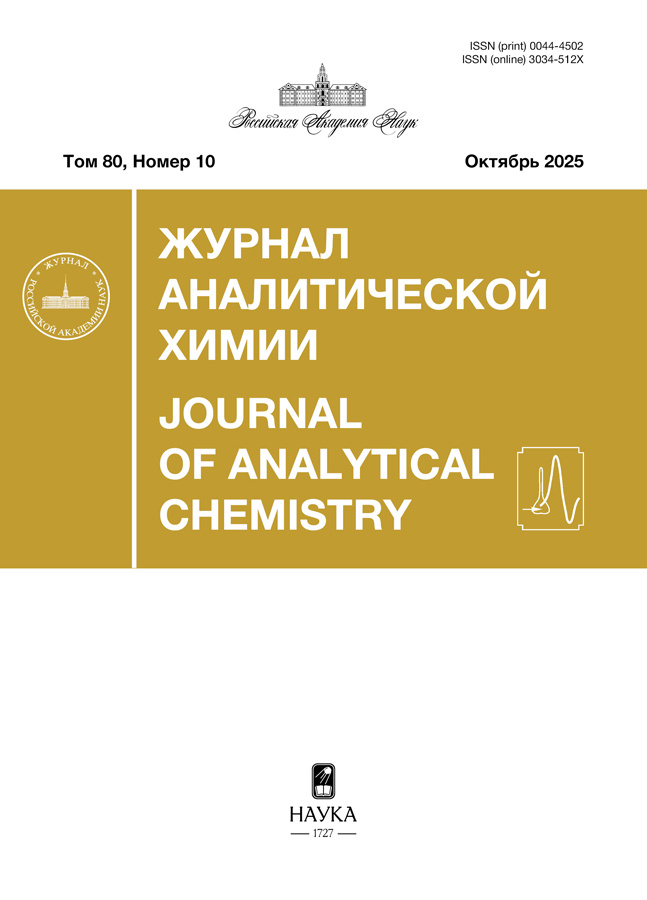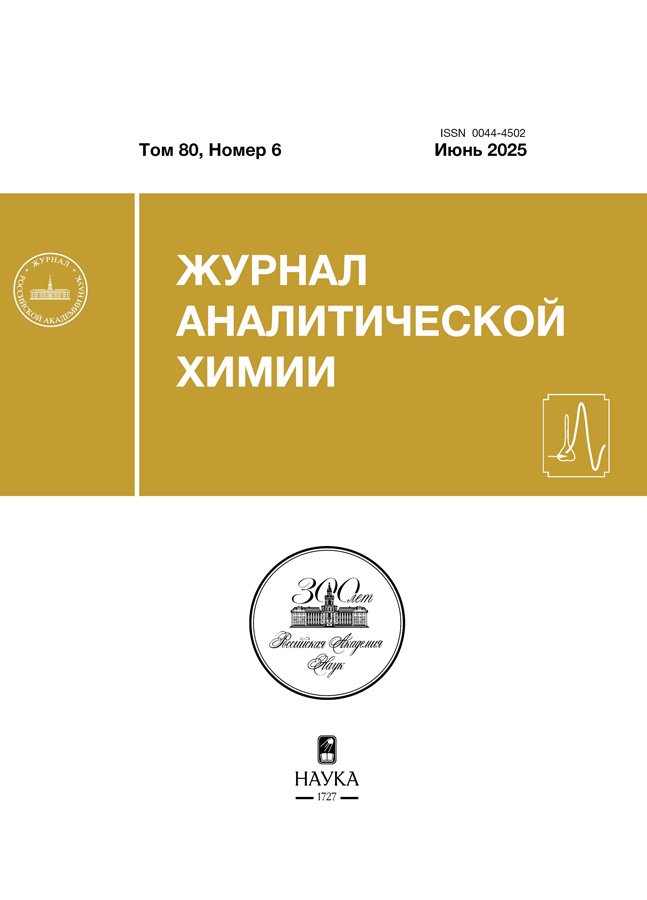Повышение чувствительности иммунохроматографического анализа для определения пенициллина в молоке за счет ориентированной иммобилизации пенициллин-связывающего белка на поверхности коллоидного золота
- Авторы: Максин И.В.1,2, Куандыкова А.2, Лузянин Т.А.1,2, Иванов В.С.2, Кириллова Ю.Г.1, Хунтеев Г.А.2
-
Учреждения:
- МИРЭА – Российский технологический университет (Институт тонких химических технологий им. М.В. Ломоносова)
- ООО “РАПИД БИО”
- Выпуск: Том 80, № 6 (2025)
- Страницы: 545–557
- Раздел: ОРИГИНАЛЬНЫЕ СТАТЬИ
- Статья получена: 15.07.2025
- Статья одобрена: 15.07.2025
- URL: https://ter-arkhiv.ru/0044-4502/article/view/687588
- DOI: https://doi.org/10.31857/S0044450225060021
- EDN: https://elibrary.ru/bcfzww
- ID: 687588
Цитировать
Полный текст
Аннотация
Проведено сравнение чувствительности конкурентного иммунохроматографического анализа (ИХА) для определения пенициллина в молоке с применением конъюгатов коллоидного золота (КЗ) с рекомбинантным пенициллин-связывающим белком (ПСБ), приготовленных двумя методами – пассивной неориентированной иммобилизацией или посредством ориентированной иммобилизации при помощи антител к гистидиновой метке. Предел обнаружения оптимизированного ИХА с неориентированной иммобилизацией ПСБ составил 5 нг/мл. Используя ориентированную иммобилизацию ПСБ за счет антител к гистидиновой метке, удалось достичь предела обнаружения до 0.3 нг/мл при визуальной интерпретации. Время проведения анализа составило 10 мин. Проведено сравнение эффективности двух методов иммобилизации ПСБ. Показано, что увеличение чувствительности анализа обусловлено улучшением ориентации ПСБ и одновременным уменьшением количества связывающих сайтов на КЗ. Таким образом, ориентированная иммобилизация специфических белков на сенсорных поверхностях с использованием антител к гистидиновой метке может увеличить чувствительность анализа и одновременно уменьшить количество используемых биоспецифических реагентов. Данный подход может быть применен для простой конъюгации рекомбинантных белков с гистидиновой меткой с наночастицами.
Ключевые слова
Полный текст
Об авторах
И. В. Максин
МИРЭА – Российский технологический университет (Институт тонких химических технологий им. М.В. Ломоносова); ООО “РАПИД БИО”
Автор, ответственный за переписку.
Email: maxinivanv@gmail.com
Россия, просп. Вернадского, 86, 119571 Москва; Большой бульвар, 42, стр.1, 121205 Москва
А. Куандыкова
ООО “РАПИД БИО”
Email: maxinivanv@gmail.com
Россия, Большой бульвар, 42, стр.1, 121205 Москва
Т. А. Лузянин
МИРЭА – Российский технологический университет (Институт тонких химических технологий им. М.В. Ломоносова); ООО “РАПИД БИО”
Email: maxinivanv@gmail.com
Россия, просп. Вернадского, 86, 119571 Москва; Большой бульвар, 42, стр.1, 121205 Москва
В. С. Иванов
ООО “РАПИД БИО”
Email: maxinivanv@gmail.com
Россия, Большой бульвар, 42, стр.1, 121205 Москва
Ю. Г. Кириллова
МИРЭА – Российский технологический университет (Институт тонких химических технологий им. М.В. Ломоносова)
Email: maxinivanv@gmail.com
Россия, просп. Вернадского, 86, 119571 Москва
Г. А. Хунтеев
ООО “РАПИД БИО”
Email: maxinivanv@gmail.com
Россия, Большой бульвар, 42, стр.1, 121205 Москва
Список литературы
- Chen J., Ying G.G., Deng W.J. Antibiotic residues in food: Extraction, analysis, and human health concerns // J. Agric Food Chem. 2019. V. 67. № 27. P. 7569. https://doi.org/10.1021/acs.jafc.9b01334
- О безопасности пищевой продукции (ТР ТС 021/2011) [Электронный ресурс]. https://eec.eaeunion.org/comission/department/deptexreg/tr/PischevayaProd.php (9 сентября, 2024).
- Kharewal T., Verma N., Gahlaut A., Hooda V. Biosensors for penicillin quantification: A comprehensive review // Biotechnol. Lett. 2020. V. 42. № 10. P. 1829. https://doi.org/10.1007/s10529-020-02970-6
- Li H., Xu B., Wang D., Zhou Y., Zhang H., Xia W., Xu S., Li Y. Immunosensor for trace penicillin G detection in milk based on supported bilayer lipid membrane modified with gold nanoparticles // J. Biotechnol. 2015. V. 203. P. 97. https://doi.org/10.1016/j.jbiotec.2015.03.013
- Pollap A., Kochana J. Electrochemical immunosensors for antibiotic detection // Biosensors (Basel). 2019. V. 9. № 2. Article 61. https://doi.org/10.3390/bios9020061
- Berlina A.N., Bartosh A.V., Zherdev A.V., Eremin S.A., Dzantiev B.B. Management of factors for improving antigen–antibody interaction in lateral flow immunoassay of tetracycline in human serum samples // Biomed. Pharmacol. J. 2019. V. 12. № 1. P. 17. https://doi.org/10.13005/bpj/1609
- Ahmed S., Ning J., Peng D., Chen T., Ahmad I., Ali A., Lei Z., Abu bakr Shabbir M., Cheng G., Yuan Z. Current advances in immunoassays for the detection of antibiotics residues: A review // Food Agric. Immunol. 2020. V. 31. № 1. P. 268. https://doi.org/10.1080/09540105.2019.1707171
- Han M., Gong L., Wang J., Zhang X., Jin Y., Zhao R., Yang C., He L., Feng X., Chen Y. An octuplex lateral flow immunoassay for rapid detection of antibiotic residues, aflatoxin M1 and melamine in milk // Sens. Actuators B: Chem. 2019. V. 292. P. 94. https://doi.org/10.1016/j.snb.2019.04.019
- Pietschmann J., Dittmann D., Spiegel H., Krause H.J., Schröper F. A novel method for antibiotic detection in milk based on competitive magnetic immunodetection // Foods. 2020. V. 9. № 12. Article 1773. https://doi.org/10.3390/foods9121773
- Hemeda S.M., Sayed R.H., Hassan H., Sheima A.E., Aboul-Ella H., Soliman R. Development of colloid gold-based lateral flow immunochromatographic kits for screening and rapid detection of beta-lactams antibiotic residues in dairy milk // Adv. Anim. Vet. Sci. 2022. V. 10. № 7. P. 1616. https://doi.org/10.17582/journal.aavs/2022/10.7.1616.1622
- Lata K., Sharma R., Naik L., Rajput Y.S., Mann B. Lateral flow assay–based rapid detection of cephalexin in milk // J. Food Qual. 2016. V. 39. № 1. P. 64. https://doi.org/10.1111/jfq.12175
- Zhang X., Zhao F., Sun Y., Mi T., Wang L., Li Q., Li J., Ma W., Liu W., Zuo J., Chu X., Chen B., Han W., Mao Y. Development of a highly sensitive lateral flow immunoassay based on receptor-antibody-amorphous carbon nanoparticles to detect 22 β-lactams in milk // Sens. Actuators B: Chem. 2020. V. 321. Article 128458. https://doi.org/10.1016/j.snb.2020.128458
- Chen Y., Wang Y., Liu L., Wu X., Xu L., Kuang H., Li A., Xu C. A gold immunochromatographic assay for the rapid and simultaneous detection of fifteen β-lactams // Nanoscale. 2015. V. 7. № 39. P. 16381. https://doi.org/10.1039/c5nr04987c
- Серченя Т.С., Семижон П.А., Счесленок Е.П., Горбачева И.В., Вашкевич И.И., Свиридов О.В. Метод количественного определения активного рецептора бета-лактамных антибиотиков Blar-CTD для биоаналитического применения // Журн. прикл. биохимии и микробиол. 2023. Т. 59. № 1. C. 81. https://doi.org/10.31857/S0555109923010105 (Serchenya T.S., Semizhon P.A., Schaslionak A.P., Harbachova I.V., Vashkevich I.I., Sviridov O.V. A method for the quantitative determination of the active receptor of beta-lactam antibiotics BlaR-CTD for bioanalytical applications // Appl. Biochem. Microbiol. 2023. V. 59. № 1. P. 79. https://doi.org/10.1134/s0003683823010106)
- Li X., Pan Z., Li M., Jia X., Zhang S., Lin H., Liu J., Ma L. Europium chelate-labeled lateral flow assay for rapid and multiple detection of β-lactam antibiotics by the penicillin-binding protein // Anal. Methods. 2020. V. 12. № 28. P. 3645. https://doi.org/10.1039/d0ay01140a
- Lin H., Fang F., Zang J., Su J., Tian Q., Kumar Kankala R., Lin X. A fluorescent sensor-assisted paper-based competitive lateral flow immunoassay for the rapid and sensitive detection of ampicillin in hospital wastewater // Micromachines (Basel). 2020. V. 11. № 4. Article 431. https://doi.org/10.3390/mi11040431
- Li X., Wang X., Wang L., Yang T., Wang D. Duplex detection of antibiotics in milk powder using lateral-flow assay based on surface-enhanced raman spectroscopy // Food Anal. Methods. 2021. V. 14. № 1. P. 165. https://doi.org/10.1007/s12161-020-01870-9
- Fan R., Tang S., Luo S., Liu H., Zhang W., Yang C., He L., Chen Y. Duplex surface enhanced Raman scattering-based lateral flow immunosensor for the low-level detection of antibiotic residues in milk // Molecules. 2020. V. 25. № 22. Article 5249. https://doi.org/10.3390/molecules25225249
- Lu Z.Y., Chan Y.H. The importance of antibody orientation for enhancing sensitivity and selectivity in lateral flow immunoassays // Sens. Diagn. 2024. V. 3. № 10. P. 1613. https://doi.org/10.1039/D4SD00206G
- Кельциева О.А., Гладилович В.Д., Подольская Е.П. Металл-аффинная хроматография. Основы и применение // Научное приборостроение. 2013. Т. 23. № 1. С. 74.
- López-Laguna H., Voltà-Durán E., Parladé E., Villaverde A., Vázquez E., Unzueta U. Insights on the emerging biotechnology of histidine-rich peptides // Biotechnol. Adv. 2022. V. 54. Article 107817. https://doi.org/10.1016/j.biotechadv.2021.107817
- Zhu L., Chang Y., Li Y., Qiao M., Liu L. Biosensors based on the binding events of nitrilotriacetic acid–metal complexes // Biosensors (Basel). 2023. V. 13. № 5. Article 507. https://doi.org/10.3390/bios13050507
- Vallina-García R., del Mar García-Suárez M., Fernández-Abedul M.T., Méndez F.J., Costa-García A. Oriented immobilisation of anti-pneumolysin Fab through a histidine tag for electrochemical immunosensors // Biosens. Bioelectron. 2007. V. 23. № 2. P. 210. https://doi.org/10.1016/j.bios.2007.04.001
- Höltje J.-V. Growth of the stress-bearing and shape-maintaining murein sacculus of Escherichia coli // Microbiol. Mol. Biol. Rev. 1998. V. 62. № 1. P. 181. https://doi.org/10.1128/mmbr.62.1.181-203.1998
- Серченя Т.С., Горбачева И.В., О.В. Свиридов. Прямое конъюгирование пенициллинов и цефалоспоринов с белками для рецепторного анализа бета-лактамных антибиотиков // Биорг. химия. 2022. Т. 48. № 1. C. 63. https://doi.org/10.31857/s0132342322010122 (Serchenya T.S., Harbachova I.V., Sviridov O.V. Direct conjugation of penicillins and cephalosporins with proteins for receptor assays of beta-lactam antibiotics // Russ. J. Bioorg. Chem. 2022. V. 48. № 1. P. 85. https://doi.org/10.1134/s1068162022010125)
- Zvereva E.A., Byzova N.A., Sveshnikov P.G., Zherdev A.V., Dzantiev B.B. Cut-off on demand: Adjustment of the threshold level of an immunochromatographic assay for chloramphenicol // Anal. Methods. 2015. V. 7. № 15. P. 6378. https://doi.org/10.1039/c5ay00835b
- Kumar D., Mutreja I., Sykes P. Seed mediated synthesis of highly mono-dispersed gold nanoparticles in the presence of hydroquinone // Nanotechnology. 2016. V. 27. № 35. Article 355601. https://doi.org/10.1088/0957-4484/27/35/355601
- Byzova N.A., Safenkova I.V., Slutskaya E.S., Zherdev A.V., Dzantiev B.B. Less is more: A comparison of antibody-gold nanoparticle conjugates of different ratios // Bioconjug. Chem. 2017. V. 28. № 11. P. 2737. https://doi.org/10.1021/acs.bioconjchem.7b00489
- Frens G. Controlled nucleation for the regulation of the particle size in monodisperse gold suspensions // Nat. Phys. Sci. 1973. V. 241. № 105. P. 20. https://doi.org/10.1038/physci241020a0
- Posthuma-Trumpie G.A., Korf J., Van Amerongen A. Lateral flow (immuno)assay: Its strengths, weaknesses, opportunities and threats. A literature survey // Anal. Bioanal. Chem. 2009. V. 393. № 2. P. 569. https://doi.org/10.1007/s00216-008-2287-2
- Li J., Duan H., Xu P., Huang X., Xiong Y. Effect of different-sized spherical gold nanoparticles grown layer by layer on the sensitivity of an immunochromatographic assay // RSC Adv. 2016. V. 6. № 31. P. 26178. https://doi.org/10.1039/c6ra03695c
- Byzova N.A., Zherdev A.V., Khlebtsov B.N., Burov A.M., Khlebtsov N.G., Dzantiev B.B. Advantages of highly spherical gold nanoparticles as labels for lateral flow immunoassay // Sensors. 2020. V. 20. № 12. Aritcle 3608. https://doi.org/10.3390/s20123608
- Khlebtsov B.N., Tumskiy R.S., Burov A.M., Pylaev T.E., Khlebtsov N.G. Quantifying the numbers of gold nanoparticles in the test zone of l ateral flow immunoassay strips // ACS Appl. Nano Mater. 2019. V. 2. № 8. P. 5020. https://doi.org/10.1021/acsanm.9b00956
- Дыкман Л.А., Хлебцов Н.Г. Методы химического синтеза коллоидного золота // Успехи химии. 2019. Т. 88. № 3. C. 229. http://dx.doi.org/10.1070/RCR4843?locatt=label:RUSSIAN (Dykman L.A., Khlebtsov N.G. Methods for chemical synthesis of colloidal gold // Russ. Chem. Rev. 2019. V. 88. № 3. P. 229. https://doi.org/10.1070/RCR4843)
- Perrault S.D., Chan W.C.W. Synthesis and surface modification of highly monodispersed, spherical gold nanoparticles of 50–200 nm // J. Am. Chem. Soc. 2009. V. 131. № 47. P. 17042. https://doi.org/10.1021/ja907069u
- Kausaite-Minkstimiene A., Ramanaviciene A., Kirlyte J., Ramanavicius A. Comparative study of random and oriented antibody immobilization techniques on the binding capacity of immunosensor // Anal. Chem. 2010. V. 82. № 15. P. 6401. https://doi.org/10.1021/ac100468k
- Song H.Y., Zhou X., Hobley J., Su X. Comparative study of random and oriented antibody immobilization as measured by dual polarization interferometry and surface plasmon resonance spectroscopy // Langmuir. 2012. V. 28. № 1. P. 997. https://doi.org/10.1021/la202734f
- Tripathi K., Driskell J.D. Quantifying bound and active antibodies conjugated to gold nanoparticles: A comprehensive and robust approach to evaluate immobilization chemistry // ACS Omega. 2018. V. 3. № 7. P. 8253. https://doi.org/10.1021/acsomega.8b00591
Дополнительные файлы























